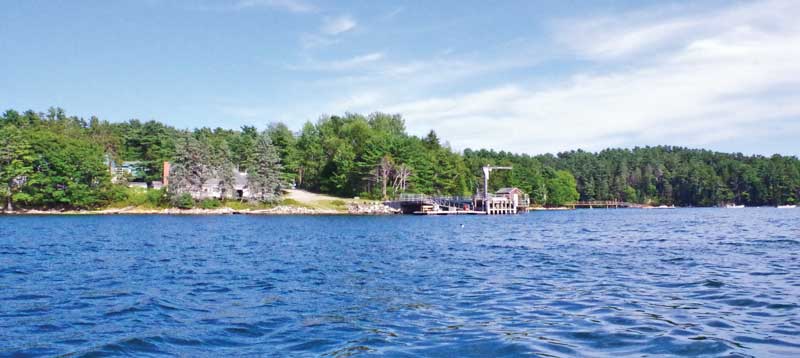 The Darling Marine Center waterfront as seen from the Damariscotta River.
The Darling Marine Center waterfront as seen from the Damariscotta River.
The Damariscotta River shimmers a brilliant blue-green. Only the screeching of terns and gentle washing of waves interrupts the quiet. Some boats are parked in the meadow on the hill, others are moored offshore or at the dock. SCUBA gear dries on wooden racks.
Inside a cluster of buildings tucked under trees along the shorefront, students huddle around laptops, tanks of sea creatures burble and buzz, and scientists bow their heads over microscopes. Since 1965, students and researchers from the University of Maine and beyond have learned about the sea here at the Darling Marine Center, a 127-acre saltwater farm and woodlot in Walpole that was donated to the University of Maine by Ira and Clara Darling in the 1960s.
The center is one of at least 18 marine laboratories and coastal field stations in Maine. This notably high number of research stations gives this rural state a starring role in regional efforts to understand the marine environment. The diversity of habitat along the state’s 3,500 miles of coastline has drawn researchers for decades, and the results of their work have been impressive, leading to scientific and medical breakthroughs, as well as vital insights into the effects of climate change, and other environmental shifts.
“No one place, no matter how fantastic the people or facilities, is enough to understand the dynamic and changing Gulf of Maine. We need a network of field stations and marine labs to do that,” said Darling Marine Center Director Heather Leslie. “In addition to having such a big coast, and needing a network of facilities to match, we also have a strong history of natural history, science, and collaboration with industry and communities.”
 Jane Crosen, Mapmaker with Barbara Tedesco
Jane Crosen, Mapmaker with Barbara Tedesco
A history of ocean inquiry
The human relationship with the Maine shoreline is long and deep. The native Wabanaki people developed their own knowledge of the ocean over generations of questioning, exploring, and adapting. For a European in the 18th and 19th centuries, identifying species and making lists of plants and animals was an important part of documenting places and establishing oneself as a naturalist.
According to Kevin Ecklebarger, professor emeritus of marine biology at the University of Maine, there are roughly 200 marine stations in the world today. The first was established in Belgium in 1843, he said, adding, “An explosion of new marine labs occurred in the 1880s around the world and again during the 1960s in America, when the Darling Marine Center opened.”
Observers of the Maine coast, from Samuel de Champlain and Nicolas Denys in the 17th century to Henry Bigelow in the 19th, provided a historical record that can serve as a baseline for scientists working today, as well as support for the idea that Maine is the place for marine science.
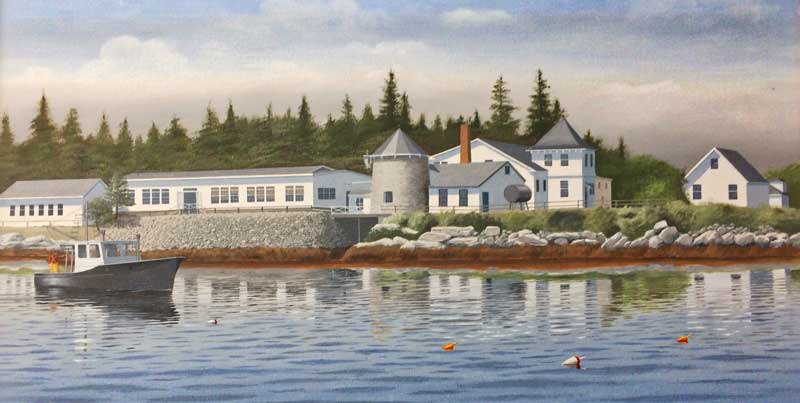 Fishery Research Station—1983 by Alden P. Stickney portrays the Maine Department of Marine Resources Boothbay Harbor laboratory. Courtesy Catherine Schmitt
Fishery Research Station—1983 by Alden P. Stickney portrays the Maine Department of Marine Resources Boothbay Harbor laboratory. Courtesy Catherine Schmitt
In July 1851, William Stimpson, a student of the famous scientist Louis Agassiz at Harvard, made a summer dredging expedition along the eastern Maine coast. He returned in later years with other student-scientists. Using a small rowboat with a sail, they ventured offshore and used oars to pull a metal rake across the sea floor. The purpose was to find and describe new specimens. Stimpson was impressed with their results. In his report to the Boston Society of Natural History, he said, “A character which cannot fail to strike the observer in this region, is that of the great profusion of animals which inhabit the sea.” He couldn’t avoid stepping on sea urchins and foot-long northern sea stars. As he sailed along the shallows, he could see a multitude of sea cucumbers below, their purple tufts waving in the current. Sometimes his passage was blocked by crowds of cross jellies. Shoals of herring and pollock fed on Mysid shrimp; whelks deposited their eggs beneath the rocks.
Later, marine scientists visited Maine from Boston, New Haven, New York, and Philadelphia. Having already studied their own backyards, they came because of the extensive coastline and the diversity of habitats that might offer new species or new evidence for their theories. Maine offers sandy beaches, salt marshes, riverine estuaries, rocky intertidal zones, bare and forested bedrock islands, salt-fogged bogs, granite mountains, and wave-battered cliffs, all of it shaped by glaciers. Southern and northern species overlap in a climate transition from temperate to boreal. Pick a marine topic, and chances are it could be studied somewhere along the Maine coast, within hours of urban intellectual hubs.
Early marine studies also coincided with economic activity. In 1867, commissioners submitted their first annual report on the status of Maine’s commercial fisheries. Working from custom houses and private residences, fish commissioners enforced laws relating to marine resources. They also worked with fishermen, such as at Boothbay, where the Samoset Island Association incorporated in 1883 to catch and “artificially propagate” lobsters from the surrounding waters. Later, the Boothbay Marine Station was used by the United States Fish Commission, joining Gloucester and Woods Hole as federal government science outposts. Alonzo R. Nickerson of Boothbay Harbor secured federal grants to build a lobster hatchery at McKown’s Point in 1904. The state purchased a 70-foot yacht, the Carita, and added a flow-through well to hold live crustaceans and fish; in this way hatchery-raised lobster and cod fry were distributed to fishing areas.
The Downeast Institute for Applied Marine Research and Education also started as a fisheries operation—the Beals Island Shellfish Hatchery—many years later, in 1987, when clammers and town officials in Washington County wanted to address declines in clam harvests. Now the institute is associated with University of Maine at Machias, and after a $6.6 million expansion in 2018, it is the easternmost marine research laboratory and education center in the United States. (Suffolk University operated a field station in Cobscook Bay from 1960 until 2016.)
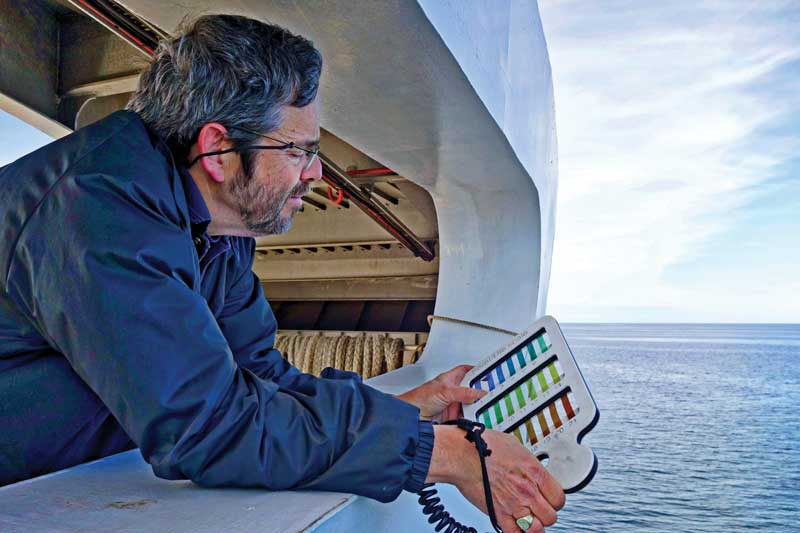 Bigelow Laboratory researcher Barney Balch uses a color scale to assess ocean conditions. Integrating historical methods and measurements into his long-term Gulf of Maine study enables Balch to examine more than a century of change in the Gulf. Photo courtesy Bigelow Laboratory
Bigelow Laboratory researcher Barney Balch uses a color scale to assess ocean conditions. Integrating historical methods and measurements into his long-term Gulf of Maine study enables Balch to examine more than a century of change in the Gulf. Photo courtesy Bigelow Laboratory
An ideal place to learn about sea and shore life
With an extensive shoreline and geography, Maine provides access to northern species of marine life not found farther south. For teachers of marine science, Maine is the place to be if students want to learn about cold-water corals, Atlantic salmon, or coastal spruce-fir forests.
Education is a major focus for most marine labs and field stations. The Mount Desert Island Biological Laboratory began as a summer course for Tufts University students when biology professor John Sterling Kingsley rented a cottage on Potts Point in South Harpswell in 1898. Summer schools were modeled after Louis Agassiz’s 1873 program at Penikese Island in Massachusetts, where he advised students to “study nature, not books.”
For many scientists in the early 1900s, Woods Hole on Cape Cod had been the center of marine research, but it was getting harder to get specimens and supplies there. Sand dollar embryos, horseshoe crabs, spiny sea urchins, starfish, and skates were scarce.
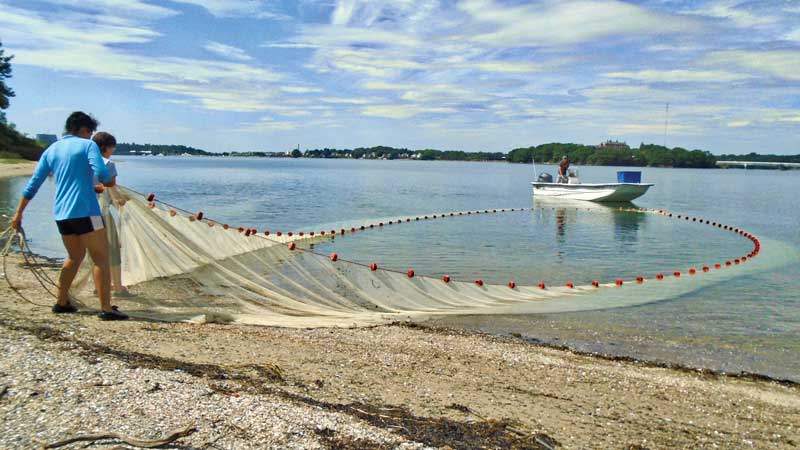 Interns at the Gulf of Maine Research Institute haul in nets as part of the organization’s long-term Casco Bay Aquatic System Survey. Photo by Richard King
Interns at the Gulf of Maine Research Institute haul in nets as part of the organization’s long-term Casco Bay Aquatic System Survey. Photo by Richard King
In Casco Bay, Kingsley and his students could access an entire ocean teeming with life. They cataloged marine invertebrates of Casco Bay, studied the anatomy of spiny dogfish and milky ribbon worms. In 1921, the laboratory moved to Salisbury Cove on Mount Desert Island, where George Dorr had offered land near Acadia National Park. The many specialized functions of fish and the simplicity and “primitive” nature of marine organisms—single-celled, symmetrical, boneless—made them ideal for studying biological questions with relevance to human health. The Mount Desert Island Biological Laboratory would become famous for research on cellular biology and how animals cope with salt.
The facility’s Community and Environmental Health Laboratory, under the direction of Jane Disney, continues to support study of the waters around Mount Desert.
 A scientist works in Bigelow Laboratory’s state-of-the-art facility, which overlooks the Damariscotta River estuary. The nonprofit’s research ranges from microscopic life at the base of marine food webs to large-scale ocean processes that affect the entire planet. Photo by Christopher Barnes
A scientist works in Bigelow Laboratory’s state-of-the-art facility, which overlooks the Damariscotta River estuary. The nonprofit’s research ranges from microscopic life at the base of marine food webs to large-scale ocean processes that affect the entire planet. Photo by Christopher Barnes
Laboratories, field stations multiply
Marine laboratories are full-service research stations with piers, vessels, lodging, classrooms, and indoor and outdoor spaces for setting up experiments. There are often tanks with live sea creatures and storage closets and barns full of old and abandoned equipment, buckets and PVC pipe, nets and bottles of chemicals. A full-service marine laboratory needs access to clean seawater and a way to flow it through laboratories in a constant and temperature-controlled supply. Some have ties to universities, while others are independent.
Bigelow Laboratory for Ocean Sciences was the “brain child of two rebel oceanographers who were sick of people telling them what to do,” said Director Deborah Bronk. Clarice and Charlie Yentsch wanted to be free from the bureaucratic constraints of more established academic laboratories. In 1974, they jumped at then Maine Department of Marine Resources Commissioner Spencer Apollino’s invitation to come to Maine. They took tools from other disciplines (medical cell-counting methods, weather satellites) and applied them to the ocean to understand global processes and identify new species. Researchers at Bigelow continue to study microscopic, “tiny giants” from phytoplankton to viruses.
Across the peninsula at the former lobster hatchery in Boothbay, Department of Marine Resources staff began to address local questions. “Anything fishermen caught that was weird, they would bring it to us,” recalled David Libby, who worked for DMR for 40 years.
In the 20th century, biologists increasingly worked indoors on specialized questions of physiology and anatomy, but the new “ecologists” resisted this shift. They wanted to study a single place for a longer period of time, to take advantage of natural experiments presented by a varied environment. As coastal areas closer to cities had degraded, the clean, wild waters of Maine became more attractive.
By the 1950s, marine science was still an on-the-water and under-the-water experience popularized by Jacques Cousteau. Universities needed field sites to fulfill the educational and experiential requirements of undergraduates. Shoals Marine Laboratory began as a single summer-long field course in 1966 on the Isles of Shoals. Today, the lab offers dozens of marine science courses and internships as the largest marine laboratory in the country focused on undergraduate education, according to Director Jennifer Seavey.
On downtown Portland’s working waterfront, Gulf of Maine Research Institute recently updated their LabVenture interactive educational experience, where 70 percent of Maine’s fifth- and sixth-grade students annually get to “see the world through data,” said Chief Scientific Officer Andrew Pershing. With origins as an aquarium in the 1960s and collaborative fisheries research center in the 1990s, the Gulf of Maine Research Institute has three floors of laboratory and meeting space where scientists study all aspects of the Gulf of Maine ecosystem, from “physics to fish sticks” as Pershing described. Out back, the smell of bait and drying nets drifts over from the Portland Fish Pier. Every summer, the lawn fills up with bluefin tuna heads as UMaine researcher Walt Golet and his students gather annual data on the population.
“The marine community here works pretty well together,” said Pershing. “There are challenges and rivalries and we compete for the same grants, but we are pretty collaborative. The coast of Maine is so varied and so long, that we need multiple labs.”
College of the Atlantic, Bates College, University of New England, and Bowdoin College established coastal field stations in the 1970s. In contrast to marine laboratories, “field stations” have minimal facilities and are often more remote. Buildings are few or absent.
What labs and field stations do have in common is access to the marine environment, a focus on long-term studies of a single location, and a feeling of being apart from usual settings and routines. At labs and field stations, visiting researchers, resident scientists, teachers, and students live and work together, discarding institutional habits for a shared interest in marine study. Different disciplines mix, and even the humanities are welcome. Away from campus, students learn the importance of history, and scientists work alongside artists and writers. Hierarchies and competition break down, and in the resulting freedom, people can follow their curiosity.
The New England Aquarium operates a seasonal field station in Lubec where right whale researchers conduct habitat monitoring in the Bay of Fundy from June through early September. The aquarium started renting the field station in 1988, then purchased it in the mid 1990s. Over 100 researchers have lived there over the years including interns from around the world.
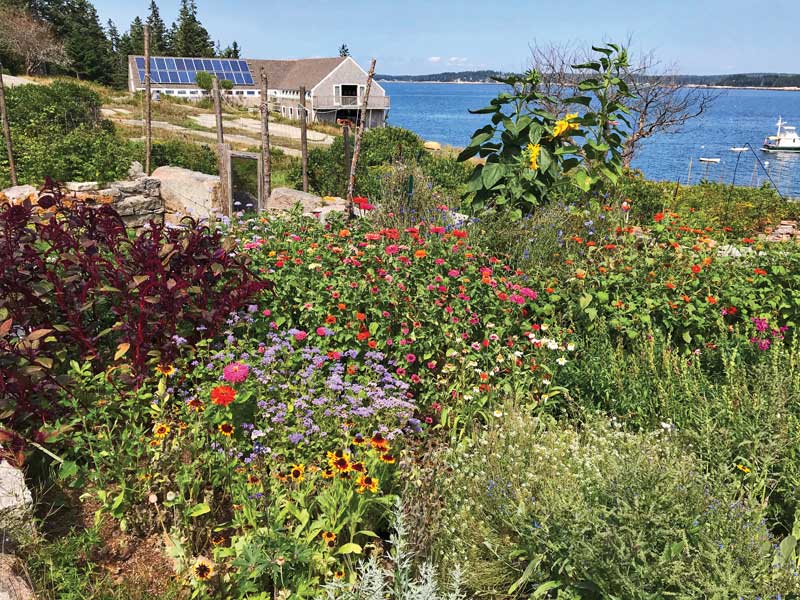 Hurricane Island was home to a granite quarry company and then an Outward Bound School before the Hurricane Island Foundation began running science-based programs there in 2009. Photo by Polly Saltonstall
Hurricane Island was home to a granite quarry company and then an Outward Bound School before the Hurricane Island Foundation began running science-based programs there in 2009. Photo by Polly Saltonstall
A place to focus, and a focus on place
Scientific inquiry also demands concentration. “All else falls away when I am doing field work, immersed in a place. I am the most focused,” said Hannah Webber of Schoodic Institute at Acadia National Park, who is studying rockweed as part of her Ph.D. research at the University of Maine. Such intense focus fosters creativity, especially when practiced in beautiful, awe-inspiring places.
Marine labs have become ideal places to study change. Being in one place long enough, researchers have the chance to accumulate (and synthesize) disparate pieces of information about the local marine environment, all of which are potentially useful for understanding the ecosystem, documenting change, and recognizing surprising and novel results.
For example, DMR’s Boothbay Laboratory has served as a weather station since 1905, providing the longest record of sea-surface temperature in Maine.
Recently, small field stations across the Gulf of Maine formed the Northeastern Coastal Stations Alliance to support data collection and data sharing across the region. In the summer of 2016 stations began collecting intertidal temperature data using a uniform deployment protocol and set of field equipment. The field station network then turned to the collection of data on intertidal plants and animals, with a goal of building long-term, gulf-wide datasets.
At the Morse River salt marshes, Bates College geology professor Bev Johnson has been studying carbon
storage and sea level rise, and students measure the changing shape of the beach. “It is really important for students to have outdoor experiences,” said Laura Sewall, Director of Bates-Morse Mountain Conservation Area and The Shortridge Coastal Center. “They get excited to study from direct experience instead of interpreted material.”
Ten miles from shore, the Isles of Shoals offers students an immersive and hands-on experience, said Director Seavey. Through independent field studies, students apply classroom learning to real-world settings on topics such as intertidal ecology, seabird populations, and marine mammal observation. Many of these studies contribute to long-term data sets. Students transform into scientists, and form a lasting connection to the archipelago.
At Hurricane Island, a 125-acre former granite quarry and Outward Bound post, and now home to the Hurricane Island Foundation, middle- and high-school students work together to address community environmental challenges. “For some of these students, it’s their first boat trip, the first time they’ve put their cell phones down, a place unlike any other in their lives,” said Caitlin Cleaver, who served as Director of Science and Research from 2014 to 2018. “They cast off everyday life and share things as a group.”
Similarly, the Downeast Institute is a major education resource for Washington County, offering marine science summer camps and curricula.
Darling Marine Center Director Leslie has also witnessed the change in students. “Every fall we welcome college students from the University of Maine and a number of other institutions to our Walpole campus. And, every fall, I am reminded anew of the power of living and learning at a marine lab like ours. The students are out on the water every day, immersed in the ecosystem that they are studying. Our Semester by the Sea students leave the Darling Center ready to engage as professionals in marine and environmental science and with a clearer sense of how to pursue their passion than when they first joined us. It’s a wonderful transformation to be part of.”
Sewall of Bates is attuned to how field experiences change the way students see. “Outside, we see distance and up-close. We see in three dimensions, up and out, and we are focused. It is an attentive, outdoor way of looking. If we don’t start paying attention, we’re not going to change the world,” she said.
“When we are attentive to the more-than-human world, we are more humble,” said Tom Fleischner of the Natural History Institute before the annual meeting of the Organization of Biological Field Stations at Schoodic Institute last September. “We should be promoting the impact of field experiences on human well-being.”
For these reasons, Maine’s marine labs and field stations are pursuing events and education programs to present people of all ages with the space and opportunity to witness and explore the coast and oceans, to discover points of inquiry and intrigue, on Maine’s long and wild edge.
Catherine Schmitt is the author of A Coastal Companion: A Year in the Gulf of Maine from Cape Cod to Canada. This article was supported by the Maine Sea Grant College Program at the University of Maine.
Behind the Story: Maine’s Marine Labs
By Catherine Schmitt
Beginning with the Marine Biological Laboratory in Woods Hole in 1998, I’ve worked at several marine labs, and visited many more on the Atlantic, Pacific, and Gulf coasts. I’ve always been attracted to and intrigued by the setting of marine labs and field stations, the feelings of family and camaraderie (and competition) that emerge from having all those people in small, remote spaces, sometimes for extended periods of time, everyone focused intensely on whatever it is they are studying.
I’ve also known the sense of place that one develops after spending time at a marine lab.
In Maine, it seemed we had a lot of labs, but I wasn’t sure of the scope or true number. No one had done an inventory like this. What I ended up writing is really a story about Maine as a place to do marine science. Historically as well as today, our remoteness and relatively unspoiled coast, proximity to academic institutions, geographic position that offers access to cold-water species, and diverse habitats from sandy beaches to rocky shores to marsh and mudflat, make this an ideal environment for scientific inquiry, for experiencing natural beauty, and learning about the sea and shore. I regret that I was not able to physically visit every lab and station while researching this story, but now that I work at a coastal “field station,” I’m sure I’ll continue to explore these subjects.
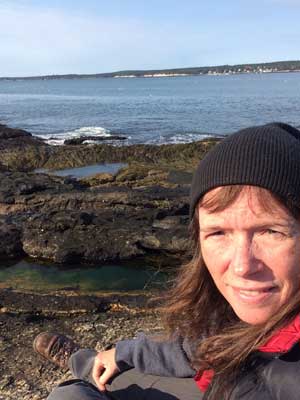 After several years at the University of Maine Sea Grant College Program, Catherine Schmitt recently began work as science communication specialist at the Schoodic Institute at Acadia National Park.
After several years at the University of Maine Sea Grant College Program, Catherine Schmitt recently began work as science communication specialist at the Schoodic Institute at Acadia National Park.






